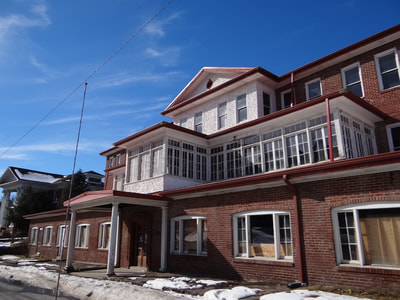|
Second Creek, Monroe County Date of Construction: c. 1800 Threat: Environmental March 2019 Update: There continues to be a powerpost beetle problem and an excessive amount of silt in the mill pond. The owner has applied for grant funding to address maintenance issues and is working with an exterminator to address the powerpost beetles. 2018: Reed’s Mill, originally named “McDowell’s Mill” was constructed by Archibald McDowell. It is believed that the mill was constructed sometime between 1791 and 1837. The grist mill is historically significant because it provides insight into the pattern of settlement in the region and for its relationship with the pioneer McDowell family who built it and the Reed family who owned and operated the mill since 1914. Second Creek has been called a power stream by those who have lived on it, and it is believed that at one time there were over 22 mills running along the Second Creek. However, Reed’s Mill is the only mill to remain in continuous operation since its construction. In 1992, Larry Mustain became owner of the mill, and he and his son, still work the mill producing two varieties of high quality buckwheat flour. Until recently, the water-powered turbine mill derived its power from Second Creek, but today the mill is electrically operated and also houses a broom-making shop. The mill is located about a mile down Second Creek Road off US 219.
Harpers Ferry, Jefferson County
Date of Construction: 1884 Threat: Deterioration, Pests March 2019 Update: The Harpers Ferry Foundation is looking forward to several hands-on projects in the spring and summer 2019 while fundraising for a new roof. In the past six months, the volunteer group have created a handsome new display case sign for the building and cleaned the sanctuary of biohazards (pigeon droppings). 2017: The First Zion Baptist Church is a contributing building in the Harpers Ferry Historic District. It is located on West Ridge Street behind the Harpers Ferry Town Hall. The church’s African-American congregation built the church, which was a keystone meeting place for the community that developed around Strorer College (a historically black college). The church was not only used for worship but was also an educational facility and gathering place over the years. After the U.S. Supreme Court decision, Brown v. The Board of Education, the West Virginia Legislature stopped funding Storer College and shifted state funds to other West Virginia historically black colleges and universities. This defunding made it impossible for the college to stay open. With the closure of Storer College in 1956, the black community in Harpers Ferry began to dwindle, as did the church congregation. The church held its last function in 2009 – an interfaith revival. Since then it has sat abandoned, under-used, and neglected. The building is structurally sound although it is increasingly exposed to the elements and continues to deteriorate. In February 2017, the Harpers Ferry-Bolivar Historic Town Foundation purchased the building with hopes to preserve its historical significance while re-using the structure as a secular community cultural center that celebrates the African-American heritage of the area. The Town Foundation needs immediate help fundraising for the preservation of the structure. If you are interested in donating to the cause, visit http://www.historicharpersferry.com/index_eecms.php/first-zion-baptist-church. Mt. Hope, Fayette County Date of Construction: 1910 Threat: Deterioration 2019 Update: The owners are looking to repair the roof and windows in the near future. There is a space for a beautician to have a shop, and the owners are looking for someone to utilize the space. 2017: The Mountainair Hotel is the largest contributing structure in the Mt. Hope Historic District. It is an anchor building in the historic district and is historically significant because of its connection to mining. The New River Company constructed the building in the downtown commercial area of Mt. Hope following a fire that devastated the town in 1910. The structure was first used to house office workers, but over time it was transformed into a “club house” for miners and then a hotel to host businessmen. Over the last century, it was known by three different names: Hotel Mount Hope, the New River Hotel, and eventually the Mountainair Hotel. In 1931, it was expanded to 50 hotel rooms and featured a banquet hall and coffee shop. The hotel closed in 1965 after the coal industry in the area began to decline, and Mt. Hope lost over a fifth of its residents between 1950 and 1960.
Over the years, however, a building of this size has proven difficult to maintain, and the Cottles have inherited compromised bricks and mortar. The Cottles are currently seeking funding resources and assistance in rehabilitating the exterior of the structure.
|
Endangered Properties ListIf you are interested in assisting with any of these preservation projects, contact the Preservation Alliance of West Virginia at [email protected].
Categories
All
Archives
March 2024
|
Get Involved |
Programs |
Contact UsPreservation Alliance of West Virginia
421 Davis Avenue, #4 | Elkins, WV 26241 Email: [email protected] Phone: 304-345-6005 |
Organizational Partners:
© COPYRIGHT 2022 - PRESERVATION ALLIANCE OF WEST VIRGINIA. ALL RIGHTS RESERVED.











 RSS Feed
RSS Feed



